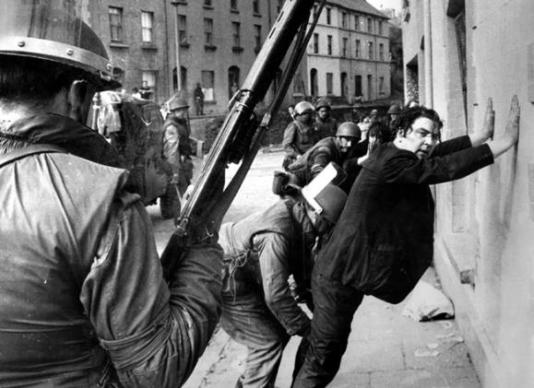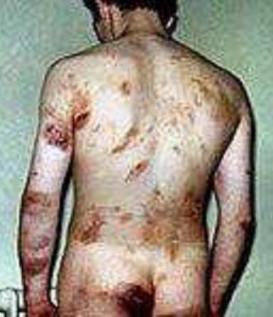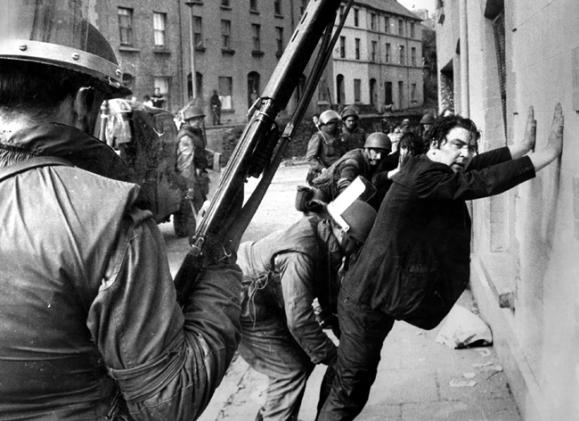
Back in June of this year Ireland’s public service broadcaster RTÉ finally got around to examining the long history of Britain’s use of physical and psychological torture against Irish men, women and children in a television documentary called “The Torture Files”. It caused a minor furore in the country before the news media hurriedly moved to more ideologically palatable stories leaving it once again to online entities like An Sionnach Fionn to continue the task of shining a light into the darker corners of Britain’s counter-insurgency war in Ireland, corners that many self-serving interests would prefer were quietly forgotten about (unlike the rather more recent occurrences of historic abuse by other belligerents in the conflict). Now, after years of stonewalling and prevarications by Dublin governments of all hues, the Irish authorities are to support the reopening of a seminal case against Britain brought before the European Court of Human Rights in 1978.
From the Associated Press:
“Ireland has accused Britain of torturing 14 Irish Republican Army suspects in 1971 and formally petitioned the European Court of Human Rights to review its original findings on the case, reopening one of the biggest legal disputes from the Northern Ireland conflict.
That landmark judgment ruled that British security forces in 1971 employed interrogation techniques against the 14 men which were “inhuman and degrading” but fell short of meeting legal definitions of torture. The United States cited that judgment as part of its legal defence a decade ago of various aggressive interrogation practices, including waterboarding, of al-Qaida suspects in the Guantanamo Bay detention camp.
A British government inquiry in 1972 found that the 14 suspects — dubbed the “hooded men” because their heads were kept covered for days in custody — had been targeted by experimental sensory deprivation techniques intended to disorient the men and break their will to resist questioning about IRA activities. They were denied sleep, food and drink, exposed to continuous white noise, and forced for protracted periods to stand spread-eagled against a wall.
The newly uncovered government records, obtained by Irish documentary makers and used in a June broadcast, suggest that Cabinet-level British government officials authorized the interrogation methods and were concerned that the practices might constitute torture. These documents were not disclosed to the European court.”
The experiences of the “Hooded Men” were recounted in a publication called “The Guinea Pigs”, a book by the journalist John McGuffin that so worried successive British governments that they banned it from sale or importation into Britain.
“But electric-shock treatment was not the only ‘experiment’ undertaken by zealous interrogators, intent on brushing up their techniques. The ALJ report isolated cases of the Falanga (beatings of the soles of the feet with heavy rods) being used, and also the water torture. The latter appears to have been used only during the months of October and November 1972 at the Black Mountain Army post and at the Grand Central Hotel. Two of the victims, Liam Holden and William Parker, told how they had had water poured slowly through a towel over their faces until they felt themselves suffocating. This is of course a well-known torture used in particular by the French in Algeria and the present military regime in Greece. After a lengthy treatment of this kind, Holden ‘confessed’ to shooting a soldier in Ballymurphy. In most cases where the sole evidence against a man has been his own alleged ‘confession’, the judges in Northern Ireland have thrown the cases out of court and the Special Branch have been content to arrest the acquitted man as he tries to leave the court and send him to the detention camp at Long Kesh. In Holden’s case, however, he was convicted as a result of his ‘confession’ and sentenced to death.”

However the use of torture by the British Forces in Ireland, military and paramilitary, during the first two decades of the conflict in the north-east of the nation went far beyond a handful of individuals but effected hundreds of Irish citizens, as detailed in a report examining the practices in two British Army bases across a period of just twelve weeks in 1971-72:
‘THE PRINCIPAL METHODS OF TORTURE USED IN HOLYWOOD AND GIRDWOOD BARRACKS:
- Placing a man in “search position,” single finger of each hand to the wall, legs well apart and well back, on the toes, knees bent, for prolonged periods. [After a period of 5 minutes in the “search position” prisoner begins to experience discomfort in arms and legs. After 10 minutes it starts to become painful. After 15 to 20 minutes majority of prisoners collapse]
- Heavy punching to the pit of the stomach to man in “search position.” [The exposed nature of the position increases force of blow, causing the prisoner to fall forward and to ground, usually causing greater injuries]
- Kicking the legs from under a man in the “search position” so that he falls to the ground, banging his head on the wall, or radiator, or ground.
- Beating with batons on the kidneys and on the privates in “search position.” [The exposed nature of the position increases force of blows, causing the prisoner to fall forward and to ground, usually causing greater injuries]
- Kicking between the legs while in the “search position.” This is very popular among the RUC officers [paramilitary police] and they often do it for periods of half an hour or an hour. [The exposed nature of the position increases force of blows, causing the prisoner to fall forward and to ground, usually causing greater injuries. After 3 or 4 kicks many prisoners will collapse or fall into unconsciousness]
- Putting a man in “search position” over a very powerful electric fire or radiator. [Prisoner suffers both from the painful nature of the “search position” and heat from the fire or radiator, often inducing burns to the legs, lower torso, arms and face]
- Stretching a man over benches with two electric fires underneath and kicking him on the stomach. [Prisoner suffers both from the painful nature of the position, with the heat from the fires inducing burns to the legs and torso, as well as the blows to the stomach. Fainting from pain and trauma is common.]
- Rabbit punching to the back of the neck while in “search position.” [The exposed nature of the position increases force of blow, causing the prisoner to fall forward and to ground, usually causing greater injuries]
- Banging the head against the wall. [A favoured method, breaking noses, fracturing jaws, causing damage to eyes and teeth, and inducing unconsciousness in prisoner]
- Beating the head with a baton in crescendo fashion. [A favoured method, breaking noses, fracturing jaws, causing damage to eyes and teeth, and inducing unconsciousness in prisoner]
- Slapping the ears and face with open hand. [A favoured method, causing pain and inducing disorientation in prisoner]
- Twisting the arms behind the back and twisting fingers. [A favoured method, causing fracturing and ligament damage to fingers and arms, and inducing unconsciousness in prisoner]
- Prodding the stomach with straight fingers. [A favoured method, causing pain and inducing disorientation in prisoner]
- Chopping blows to the ribs from behind with simultaneous blows to the stomach. [A favoured method, causing pain and inducing disorientation in prisoner]
- Hand squeezing of the testicles. [A favoured method, causing pain, inducing disorientation, humiliation and fear in prisoner]
- Insertion of instruments in the anal passage. [A favoured method, causing pain, inducing humiliation and fear in prisoner]
- Kicking on the knees and shins. [A favoured method, causing pain and inducing disorientation in prisoner]
- Tossing the prisoner from one officer to another and punching him while in the air. [A favoured method, causing pain and inducing disorientation in prisoner]
- Injections. [So-called “injections” could be made with the use of an empty syringe, inserting a needle into vulnerable parts of the body, including the gums, testes, penis, hands, etc. to cause pain or fear in a prisoner. Otherwise a cocktail of narcotics were used in actual injections, usually amphetamine or “speed”. However in British installations at this period other drugs were also used on prisoners including sodium thiopental and sodium amytal (the so-called “truth drugs”), lysergic acid diethylamide (“LSD” or “acid”) and, later, heroin. Sometimes prisoners were threatened with syringes claimed to be filled with a poisonous or contagious substance]
- Electric cattle prod was used. [Causes pain, disorientation and fear in prisoner]
- Electric shocks given by use of a machine. [Causes pain, disorientation and fear in prisoner]
- Burning with matches and candles. [Causes pain, disorientation and fear in prisoner]
- Deprivation of sleep. [Causes disorientation and fear in prisoner making them more susceptible to physical and psychological torture]
- Urinating on prisoners. [Causes humiliation and feelings of degradation in prisoner]
- Psychological tortures:
(a) Russian roulette. [Loading a revolver pistol with one bullet, leaving the other chambers empty, spinning the chambers, holding the weapon to the prisoner’s head and pulling the trigger]
(b) Firing blanks. [Fired to the side or back of the head of hooded or unhooded prisoners]
(c) Beating men in darkness. [Prisoners in a darkened room, hooded or blindfolded and beaten by up to a dozen men with fists, boots, truncheons, sticks, etc. over a period of 5 to 15 minutes]
(d) Blindfolding. [Prisoners left blindfolded, and normally handcuffed or otherwise bound, for periods of 48 to 72 hours]
(e) Assailants using stocking masks.
(f) Wearing surgical dress. [Prisoners led to believe that they were to be subject to torture via invasive surgery]
(g) Staring at white perforated wall in small cubicle.
(h) Use of amphetamine drugs. [Commonly known as ‘speed’, prisoners injected with high doses inducing fever-like conditions, disorientation, confusion, blurred vision, numbness, etc. Frequently administered by military medical personnel in co-operation with interrogators]
(i) Prisoners are threatened; threats to their families, bribes offered, false confessions are used. [Intelligence information gleaned through informers, spies, surveillance, etc. frequently used to overawe, intimidate prisoners. Threats of murder, beatings, rape and sexual assault made against the family members of prisoners, including children and the elderly, sometimes with the use of photos or film montages of family members taken by Forces’ personnel. High sums of money, reaching into the tens of thousands, offered as bribes. Pre-written confessions signed by prisoners under threat]’

It’s difficult to read all of it because of the cruelty inflicted on the innocent heroes. We must do our part to negate the imperialism and horror administered by British and Unionist heathens.
signed by Ronnie Austin
LikeLike
Seamas,
Sorry to barge in on this topic.
But over on the Pensive Quill…Gerard Murphy has just published an article on his book ” The year of disappearences”
I think you would be able to add to the debate going on over there..I have not read his book. So I am unable to refute his thoughts myself.
Anyhow here’s the link.
http://thepensivequill.am/2014/12/thinking-inside-box.html
LikeLike
Left a Comment, though not sure if it got through:
“Perhaps the reason Gerard Murphy glosses over the criticisms of those who have reviewed his book and opts instead for attacks on their personal character, complete with comparisons to Nazi propagandists, is because he has no real defence to offer? And perhaps the reason Ed Moloney, a staunch opponent of “Provisional” republicanism and chronicler of that movement’s history, has dismissed the “massacre” theories of Murphy and co. is because he recognises counter-factual nonsense when he comes across it?
Fantastical tales of Protestant boys being rowed out to sea to seek a watery doom at the hands of Republican harridans may titillate the apologist commentariat of Harris, Dudley-Edwards and the rest of the Dublin media elite but they ring pretty hollow to the rest of us.
Less of a “perspective” and more of a fist-shaking come ye all to Murphy’s detractors.”
LikeLike
Yes, Seamas it got through..
Mind you I find this whole subject bizarre.
On the one hand you have people like Harris , Edwards et al who use books like this to promote there West Brit agenda.And their conclusion is we should have stayed under Brit Rule. I can’t accept this .
On the other hand you have SF and the Provisional movement who use this to rub the noses of the Free Staters into seeing how the Free State was born, in violence. And therefore to mute criticism of the R.M.
I see the merit of this as too many Free Staters are too readily to buy into the Brit argument that the poor Brits were in the middle of two tribes..thus letting the Brits off the hook.
So, books like this can serve a purpose beyond which of the agenda of the author intended.
It seems Gone are the days of people just reporting historical facts…In Full..And then reaching a conclusion.
It seems books must be written in such a way as to serve an agenda. and the “facts” made fit.
My conclusion is as ever..Innocent people may have suffered..But If there was No Brit presence..Then it wouldn’t have been necessary. But We never had that option available.
I would love to see If he talks about that episode about the boat and the Sea.
He really needs to explain that one.
LikeLike
Nothing has changed. The British Army has been using the same techniques in Iraq and Afghanistan. Also summery executions to “Dispose” of the evidence. An award winning film producer friend, who I introduced to a journalist who had collected evidence about all this in Iraq, has had a nasty 10 year fight to get the truth out. He has of course been subjected to the usual “Cover-Up” techniques. This whole thing makes me sick. The “Cabinet office officials” would have been advising, explicitly, the Cabinet Ministers that were relevant. “Letters of comfort” would have been signed off by the Ministers to give the officials protection, and authorizing it all. Ditto the officials to the senior military officers involved. no criminal investigations, of course.Contrast this with the mysterious disappearance of “Pardons” given to certain Republicans, and the disgraceful treatment of the Price Sisters. Nothing changes. I think this is not history though. If the cases can be forced onto the judicial system, then the PSNI need to be pressured into historic investigations. It is still not too late. Ex-Minister John Stonehouse, are you still alive?…..if so, Justice might finally be done.plus others. The critical thing is the way it links to the Anglo/US “War on Terror”. UK spooks and military/special forces are still doing this. it has relevance. The legal and political impunity of them is still killing thousands. Pursuing this case in the civil and criminal courts can save lives, today. I hope this happens, but in today’s plastic, fake Irish politics, grovelling to the Anglo-Americans takes precedence over all else. I despair. I really do.
LikeLike
They are, after all, the inventors of the concentration camps, and used them very effectively against the Boer population in South Africa (some 127,000 civilians died that way – yes I am including the African civilians as well – mostly women and children). The pictures of the victims eerily resemble those some 40 years later in Germany. The same military leaders (Lord French, Ivor Guest aka Viscount Wimborne, General John Maxwell, General William Lowe, to name a few of these civilised English “gentlemen”) squashed the 1916 effort. The Germans added some extras to their copies, granted, but the general idea originates in merry old England. No one was ever hung for those crimes. Kind of gives one clue of what happened then and continued to happen into the more recent past.
LikeLike